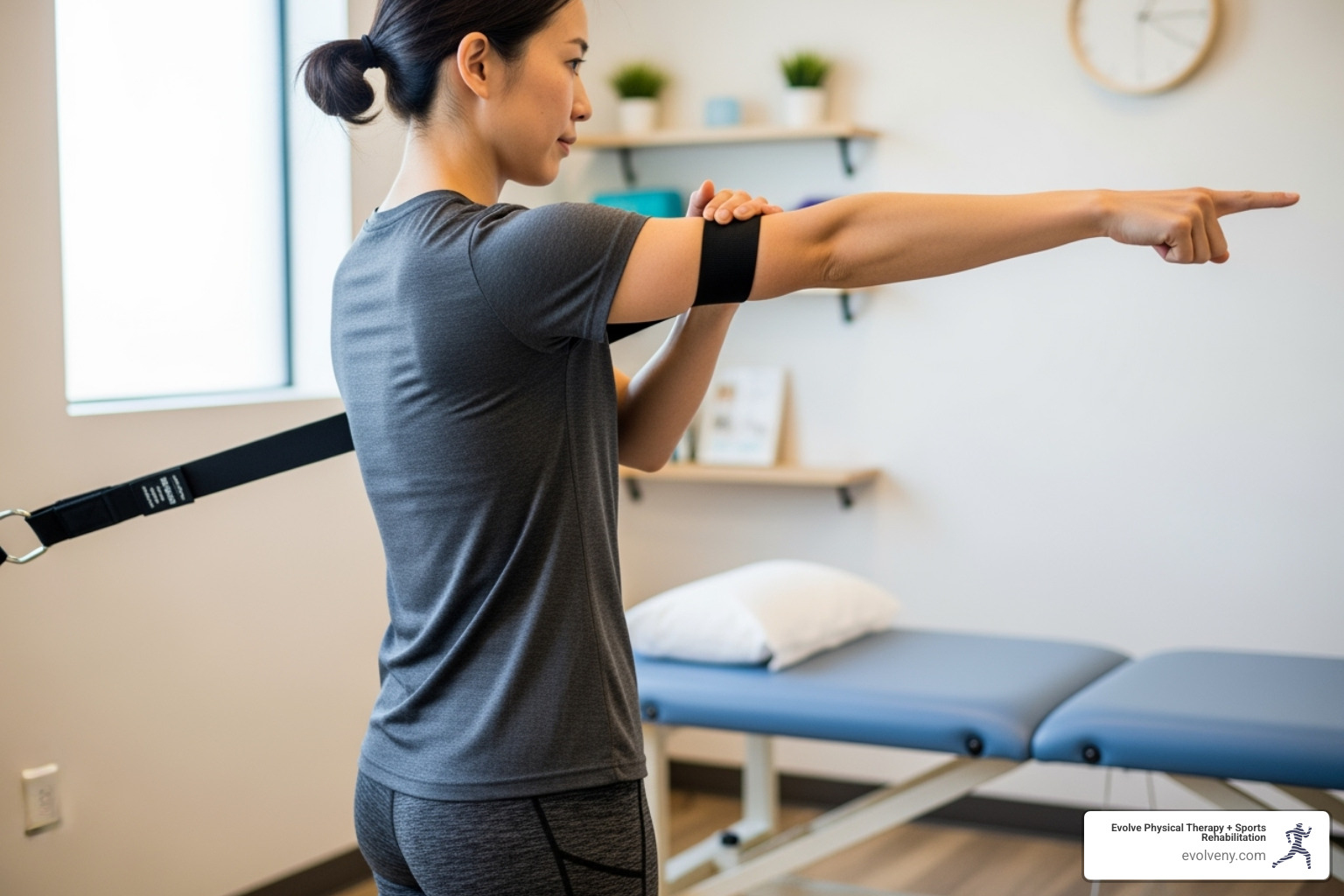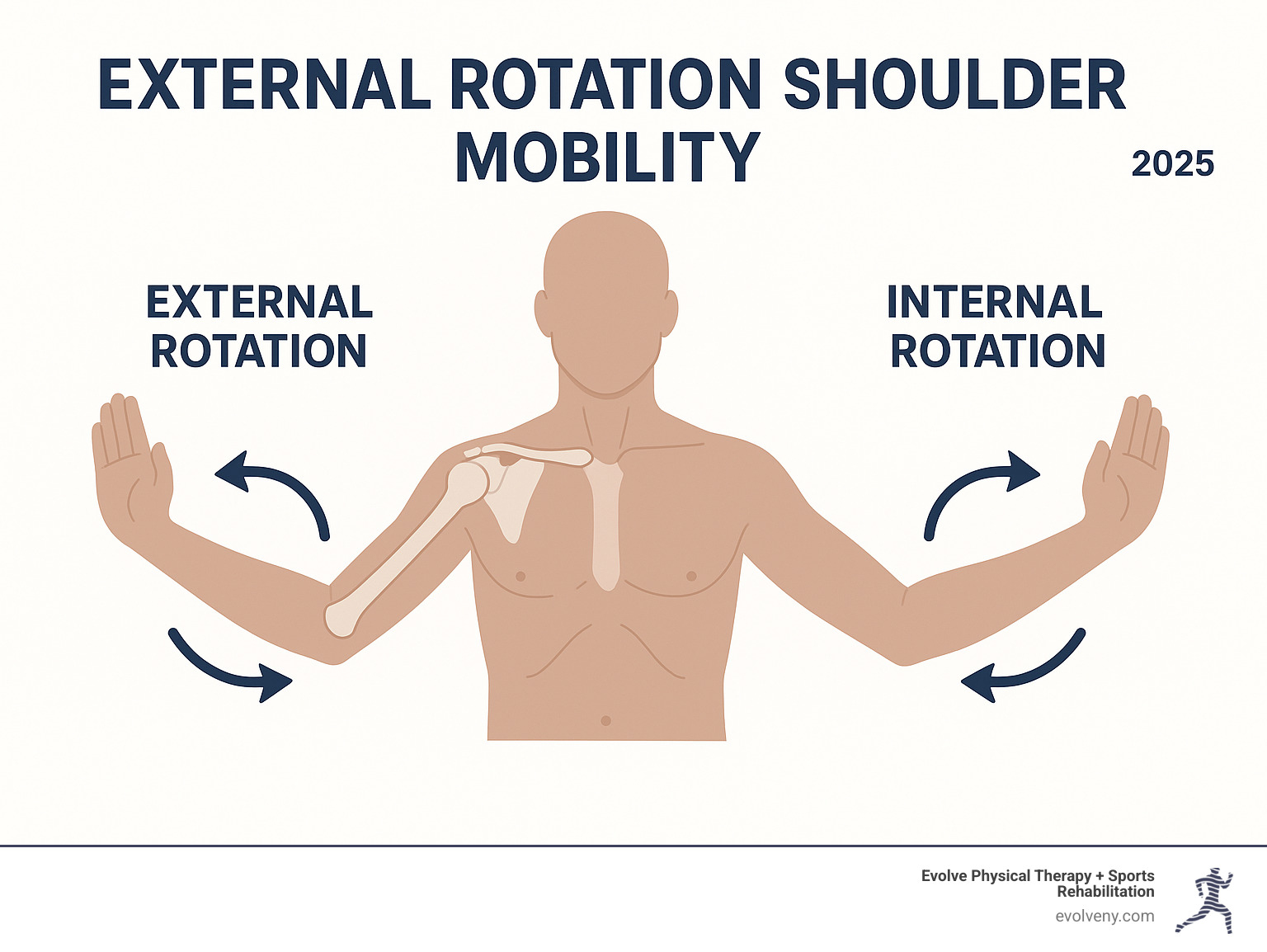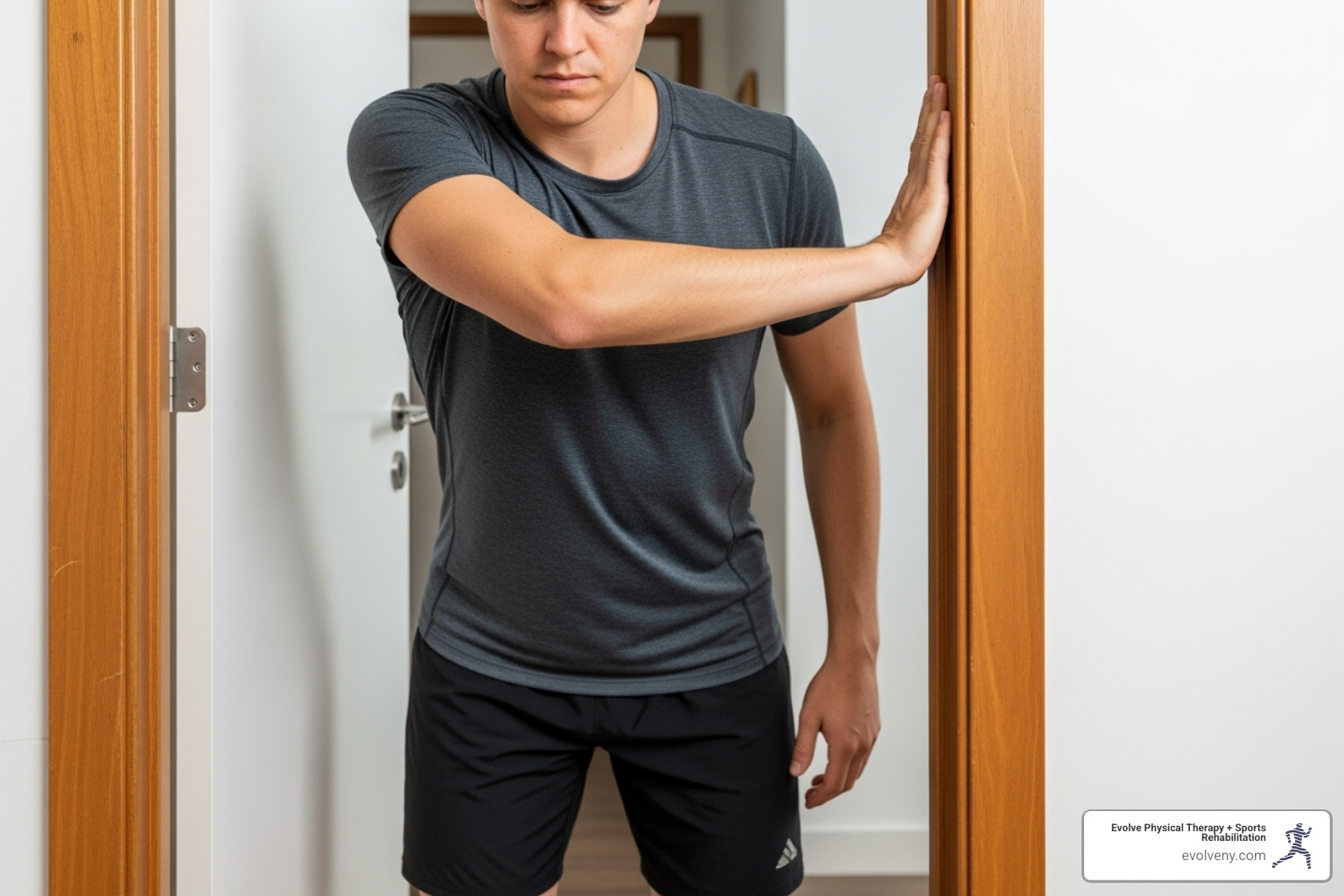Top Exercises to Boost Your Shoulder External Rotation
What is External Rotation Shoulder Mobility?

External rotation shoulder mobility—the ability to rotate your arm outward from the shoulder—is a crucial movement for daily life and overall shoulder health. This simple motion is essential for:
- Reaching overhead
- Throwing, swimming, and other sports
- Maintaining good posture
- Preventing shoulder pain and injury
Limited external rotation can make everyday tasks difficult and hold you back from your favorite activities, often causing stiffness or pain.
This guide will help you understand this key movement, assess your own mobility, and provide clear steps to improve it. Our goal is to help you move better, feel stronger, and live without shoulder pain.
As Lou Ezrick, founder of Evolve Physical Therapy, I've spent nearly two decades helping people like you improve their external rotation shoulder mobility. My experience specializing in chronic pain here in Brooklyn has shown me the power of targeted, hands-on approaches to open up your body's full potential.

Why Shoulder External Rotation is Crucial for Health and Performance
Our shoulders' glenohumeral joints are ball-and-socket structures that allow for an incredible range of motion. Within this, external rotation shoulder mobility is vital for both health and performance.
Shoulder stability is key to preventing injury. The rotator cuff muscles, particularly the infraspinatus and teres minor, are the primary external rotators. They work to keep the head of the arm bone centered in the shoulder socket. Strong and flexible external rotators act as dynamic stabilizers, preventing common injuries like shoulder impingement and rotator cuff tears.
If your external rotation shoulder mobility is limited, your body often compensates. This can lead to poor posture, like a rounded upper back, and put extra stress on other parts of the body, causing more pain.
Good external rotation is also vital for many everyday activities, such as reaching for something on a high shelf, washing your hair, or putting on a jacket. Without it, these simple actions can become frustrating or painful.
For athletes, this movement is essential. Whether you're a pitcher, tennis player, swimmer, or weightlifter performing an overhead press, strong external rotation is non-negotiable. It allows for efficient power transfer and correct joint positioning, boosting performance and preventing injury. For lifters, it helps create a stable "shelf" for the barbell, making overhead lifts safer and more effective.
To learn more about these vital muscles, check out our detailed article: More info about the rotator cuff.
How to Test Your Shoulder External Rotation Mobility at Home
Before trying to improve your shoulder mobility, a self-assessment can help you understand your current external rotation shoulder mobility and track your progress. The goal is to find what feels healthy and functional for your body. As you try these tests, pay attention to:
- Range of Motion: How far can you move comfortably?
- Symmetry: Are there differences between your shoulders?
- Pain Signals: Note any sharp pain, which is a signal to stop.
- Compensation: Is your body "cheating" by arching your back or shrugging?
Here are two simple tests you can do at home:
The Wall Test
This test assesses your active external rotation shoulder mobility without the influence of gravity.
- Stand with your back flat against a wall, with your head, shoulders, and hips touching it.
- Bring your arms up to shoulder height and bend your elbows to 90 degrees, creating a "goalpost" shape. Your upper arms should be parallel to the floor and touching the wall.
- Slowly rotate your forearms backward, trying to touch the backs of your hands to the wall.
What to look for: Ideally, the backs of your hands and forearms should touch the wall without your upper arms or back lifting away from it. If they float away, or if you feel pain or notice one side is tighter, your external rotation shoulder mobility may be limited.
The Supine 90/90 Test
This test uses gravity to help check your end range of motion.
- Lie on your back on the floor.
- Bring one arm out to the side at shoulder height, making a "T" shape with your body (abducted to 90 degrees).
- Bend your elbow to 90 degrees, with your forearm pointing toward the ceiling.
- Slowly let your forearm fall backward toward the floor, keeping your elbow bent and your upper arm flat on the floor.
What to look for: Ideally, your forearm should go parallel to the floor or touch it. If it remains significantly lifted, it's a sign of limited external rotation shoulder mobility. Pay attention to any pinching or discomfort. If you notice significant limitations or pain, it's a good idea to consult a physical therapist.
The Bigger Picture: How Other Body Parts Affect Your Shoulder
Improving external rotation shoulder mobility requires a holistic view. The body is an interconnected kinetic chain, meaning poor movement in one area can impact another. Daily habits and posture can create muscle imbalances that pull your shoulders out of their optimal position, making external rotation difficult.
The Role of Your Thoracic Spine
Your thoracic spine (mid-back) is a key player in shoulder movement. If your mid-back is stiff and lacks mobility—especially in extension and rotation—your body will seek that movement elsewhere, often from the shoulders. This can lead to poor shoulder blade (scapula) mechanics and limited arm movement, particularly overhead. Improving mid-back mobility is often a crucial step for better shoulder health. Learn more here: Why thoracic mobility is important.
Tight Pecs and Lats
Your pectoralis major (pecs) and latissimus dorsi (lats) are powerful internal rotators of the shoulder, meaning they pull your arms inward and forward. If these muscles become tight from prolonged sitting or certain exercises, they can pull your shoulders into a rounded posture. This makes it very difficult to externally rotate your arms. Releasing tension in these muscles is often a vital first step. Foam rolling can help: Using a foam roller for muscle release.
The Importance of Internal Rotation Balance
Healthy shoulders require a balance between external and internal rotation. Focusing only on external rotation or aggressively over-stretching can sometimes lead to instability. For example, some overhead athletes develop Glenohumeral Internal Rotation Deficit (GIRD), where limited internal rotation causes problems despite good external rotation. The goal is to achieve balance through controlled, active movements that strengthen the shoulder through its entire available range. Our specialized programs are designed to find this balance: Information on specialized therapeutic exercise.
A 3-Phase Routine for Better External Rotation Shoulder Mobility
Improving your external rotation shoulder mobility requires a progressive plan. Our three-phase approach helps you release tension, gain active control, and build lasting strength.
- Phase 1: Gentle Passive Stretches
- Phase 2: Active Mobility and Control
- Phase 3: Essential Strengthening Exercises
Phase 1: Gentle Passive Stretches
This phase gently increases flexibility and releases tightness to create space for better movement.

- Doorway Pec Stretch: Tight chest muscles can pull shoulders forward. To stretch them, stand in a doorway and place your forearm on the frame in a 'goalpost' position (elbow bent 90°, upper arm at shoulder height). Gently lean forward to feel a stretch in your chest. Hold for 30 seconds; repeat 2-3 times per side.
- Dowel/Stick-Assisted External Rotation: This uses a dowel or broomstick to guide your arm into a deeper stretch. Hold the stick with the arm you're stretching, elbow bent to 90 degrees and tucked into your side. Use your other hand to gently push the stick (and your arm) outwards. Go only until you feel a comfortable stretch. Hold for 30 seconds; repeat 2-3 times per side.
- Bent Arm Puppy Pose: This stretches your lats and improves overhead reach. Start on your hands and knees, then walk your hands forward, keeping your hips over your knees. Let your chest drop toward the floor, with elbows bent and palms together. Feel the stretch through your lats and shoulders. Hold for 30-60 seconds, repeating 2-3 times. See a demo here: Video demonstration of bent arm puppy pose.
Phase 2: Active Mobility and Control
Now, we teach the body to use this new range of motion with control.
- Wall Slides: This improves shoulder blade movement. Stand with your back flat against a wall. Bring your forearms and hands against the wall in a "W" shape. Slowly slide your arms up into a "Y" shape, keeping your forearms and hands on the wall without shrugging. Slowly slide back down. Aim for 10-15 repetitions.
- "Serving Cookies" Rotations: This drill actively engages your external rotators. Stand or sit tall with your elbow bent to 90 degrees and tucked into your side, palm up. Keeping your elbow glued to your side, slowly rotate your forearm outwards. Return to the start. Do 8-12 repetitions per side.
- Quadruped T-Spine Rotations: This improves mid-back mobility, which directly supports external rotation shoulder mobility. On your hands and knees, place one hand behind your head. Keeping your hips still, rotate your upper back to point your elbow toward the ceiling. Slowly return. Perform 10-12 repetitions per side.
Phase 3: Essential Strengthening Exercises
Strengthening the external rotators is crucial for making mobility gains last and protecting your shoulder.
- Side-Lying External Rotation: This isolates the infraspinatus and teres minor. Lie on your side, supporting your head with your bottom arm. Bend your top elbow to 90 degrees, resting your forearm on your stomach. You can place a small towel under your elbow. Holding a very light dumbbell (or no weight), slowly rotate your forearm up toward the ceiling, keeping your elbow tucked in. Slowly lower. Aim for 10-15 repetitions for 2-3 sets per side. Strengthening these muscles is proven to help overhead athletes: A study on overhead athletes.
- Banded External Rotations: Attach a resistance band to a sturdy anchor at waist height. Stand sideways to the anchor and grab the band. Tuck your elbow into your side, bent at 90 degrees. Pull the band outwards, rotating your forearm away from your body. Slowly return. Do 10-15 repetitions for 2-3 sets per side.
- Face Pulls: This is a powerhouse exercise for posture and shoulder health. Using a cable machine with a rope or a high-anchored band, grasp the rope with an overhand grip. Pull the rope toward your face, leading with your elbows. As you pull, rotate your shoulders outwards so your hands end up outside your elbows, squeezing your shoulder blades together. Slowly return. Aim for 10-15 repetitions for 2-3 sets.
How to Structure Your Routine and Avoid Injury
Consistency is key to improving your external rotation shoulder mobility. Occasional exercises won't create lasting change. Aim to make this routine a regular tune-up for your shoulders, always prioritizing quality of movement over quantity to avoid injury.
Sample Routine: Frequency, Sets, and Reps
Perform this routine 2-3 times per week to allow for recovery and adaptation. Start with a 5-10 minute warm-up.
- Warm-up: Perform 10-15 Arm Circles in each direction, followed by gentle Shoulder Flossing (moving arms through various ranges of motion).
Here is a sample structure for your main routine:
Phase 1: Gentle Passive Stretches
- Doorway Pec Stretch: 2-3 sets of 30-second holds per side.
- Dowel/Stick-Assisted External Rotation: 2-3 sets of 30-second holds per side.
- Bent Arm Puppy Pose: 2-3 sets of 30-60 second holds.
Phase 2: Active Mobility and Control
- Wall Slides: 2-3 sets of 10-15 repetitions.
- "Serving Cookies" Rotations: 2-3 sets of 8-12 repetitions per side.
- Quadruped T-Spine Rotations: 2-3 sets of 10-12 repetitions per side.
Phase 3: Essential Strengthening Exercises
- Side-Lying External Rotation: 2-3 sets of 10-15 repetitions per side (use very light or no weight).
- Banded External Rotations: 2-3 sets of 10-15 repetitions per side.
- Face Pulls: 2-3 sets of 10-15 repetitions.
Key Precautions for Your External Rotation Shoulder Mobility Work
- Listen to Your Body: This is the golden rule. A stretch should feel like gentle tension, not sharp or pinching pain. Stop immediately if you feel sharp pain.
- Avoid Compensation: Be mindful of your form. Don't arch your lower back or shrug your shoulders. These are signs that other muscles are taking over. Keep your core engaged.
- Start Slow and Progress Gradually: Don't force your range of motion. Start with little to no weight and increase resistance or reps as you get stronger. Patience is key.
- When to Seek Help: If you have persistent pain, limited progress, or are recovering from an injury, it's best to consult a professional. A physical therapist can provide a personalized assessment and program. Don't hesitate to seek expert guidance. When to consider shoulder physical therapy.
Frequently Asked Questions about Shoulder External Rotation
Why is my shoulder external rotation so limited on one side?
It's common to have mobility differences between shoulders. This asymmetry in external rotation shoulder mobility can result from sports that favor one side (e.g., throwing, tennis) or daily habits like sleeping on one side, carrying a bag on the same shoulder, or using a computer mouse. Past injuries can also cause lingering stiffness. Acknowledge this difference and give your tighter side extra attention during your mobility work.
Can these exercises help my overhead lifts like the snatch or overhead press?
Absolutely. For overhead lifts, improving your external rotation shoulder mobility is a game-changer. It helps create a stable "shelf" for the barbell, allowing your arm bone to sit correctly in the socket. This improves stability and helps prevent impingement. Exercises like Wall Slides and Face Pulls, combined with better thoracic mobility, can significantly improve the safety and efficiency of your lifts.
How long does it take to see improvements in my shoulder mobility?
You might feel an immediate increase in range after a session, but lasting changes require consistency. Most people notice significant, more permanent improvements in their external rotation shoulder mobility within 4 to 6 weeks of following a routine 2-3 times per week. Be patient and consistent. If you hit a plateau or experience persistent pain, it may be time to seek professional guidance from the team at Evolve Physical Therapy + Sports Rehabilitation.
Conclusion
You now understand the importance of external rotation shoulder mobility for daily tasks, athletic performance, and overall shoulder health. You have a clear, actionable plan to build a more resilient and capable shoulder by following our three-phase routine of stretching, active mobility, and strengthening.
Consistency is your key to success. A balanced approach to mobility and strength is the most effective path to improving your external rotation shoulder mobility, opening up better movement, and reducing your risk of injury.
At Evolve Physical Therapy + Sports Rehabilitation, our goal is to help you move with confidence and without pain. If you experience persistent pain, limited mobility despite your efforts, or are recovering from an injury, our team is here to help. We provide personalized assessments and treatment plans with a hands-on approach to guide your healing and strengthening.
For a comprehensive evaluation, we invite you to schedule a consultation with a physical therapist at one of our Brooklyn locations, including Marine Park, Gravesend, Midwood, Park Slope, and Mill Basin. We're ready to help you move better and feel stronger. Learn more about our physical therapy services.

